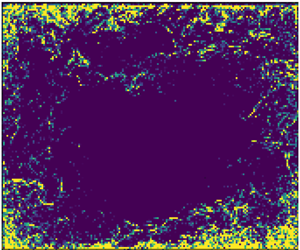Article contents
Experimental and numerical shadowgraph in turbulent Rayleigh–Bénard convection with a rough boundary: investigation of plumes
Published online by Cambridge University Press: 15 May 2020
Abstract

We show that, in the case of turbulent Rayleigh–Bénard convection, shadowgraph can be used to gain quantitative results on the plume statistics and velocity. For this purpose, we compare the experimental shadowgraph of a Rayleigh–Bénard cell with the synthetic shadowgraph obtained by calculating the integrated two-dimensional Laplacian of the temperature field from a numerical simulation very similar to the experiment. We use image processing tools to enhance the quality of the shadowgraph image, and obtain quantitative statistics for the thermal plumes, such as plume density and plume velocity distribution. To highlight the efficiency of this new process of plume counting, we use, both in the experiment and in the numerical simulation, a turbulent Rayleigh–Bénard convection cell with a rough bottom surface and a smooth top surface, where the statistics of the plumes can be influenced (or not) by the roughness. In addition, the distribution of velocity obtained from processing the synthetic shadowgraph images of the direct numerical simulations (DNS) or the experimental shadowgraph images, are compared to the velocity fluid at mid-plane of the DNS or particle image velocimetry measurement in the experiment, respectively. It will be shown that the mean velocity profile measured using the advection of the plumes is different from the average Eulerian velocity profile.
JFM classification
- Type
- JFM Papers
- Information
- Copyright
- © The Author(s), 2020. Published by Cambridge University Press
References
- 14
- Cited by


